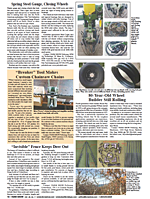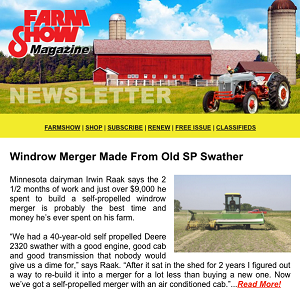You have reached your limit of 3 free stories. A story preview is shown instead.
To view more stories
(If your subscription is current,
click here to Login or Register.)
They’re Using Chickens As No-Till Seed Planters
Dave Perozzi makes his chickens work for their meals. He broadcasts seed ahead of them as he moves them to new grass. Some of the seed gets eaten. However, some of it, especially the smaller seed, gets scratched into the dirt along with chicken manure to fertilize it. After the chickens have moved to fresh grass, the s
..........
You must sign in, subscribe or renew to see the page.

You must sign in, subscribe or renew to see the flip-book
They’re Using Chickens As No-Till Seed Planters LIVESTOCK Poultry Dave Perozzi makes his chickens work for their meals He broadcasts seed ahead of them as he moves them to new grass Some of the seed gets eaten However some of it especially the smaller seed gets scratched into the dirt along with chicken manure to fertilize it After the chickens have moved to fresh grass the seed sprouts improving forage for the cattle that follow later in the year “We started after noticing seed in spilled chicken feed germinating after the chickens had been moved ” says Perozzi “The first year I spread oats daikon radish and purple top turnips I’ve tried others including peas and sunflowers but tend to circle back to the first three ” Perozzi has also tried corn and pearl millet with different degrees of success Oats radish and turnips have done well While peas germinated he found they couldn’t handle competition from pasture perennials and stalled out He had some success with the larger seeds but also noted failures such as no sunflowers emerging “The chickens have an easier time finding and eating the larger seeds ” he says “The smaller seeds are more likely to escape them especially if the pasture plants are thick ” A friend suggested Perozzi add clover seed to the feed ration He cited its potential to pass through the chicken undigested “It might work but I already have a good population of clover ” he says Perozzi is quick to point out that the right amount of soil moisture and disturbance of the soil is key to good emergence After 3 years of experimenting with the practice he’s not sure if the practice is economically sound given the effort and the cost of seed However when it works it works “We’ve had times where we got spectacular regrowth producing a really thick bed of radish and turnips ” says Perozzi “We’ve also had times we barely found any regrowth ” While the chickens do the work they don’t see the benefit Perozzi points to his heavy clay soils as the reason he pastures chickens on them only once a season “One application of chicken manure a year is about all my soils can handle ” he says “Later each season I bring in our cattle When it gets colder they like the fall greens both radish and turnip tops ” Perozzi is hesitant to recommend the practice to others yet He plans to continue with it himself “I’m still trying to understand it ” he says Contact: FARM SHOW Followup Dave Perozzi 431 Seebers Lane Canajoharie N Y 13317 ph 518-588-2633; www wrongdirectionfarm com
To read the rest of this story, download this issue below or click
here to register with your account number.





